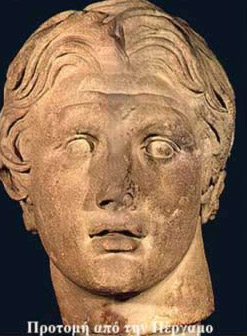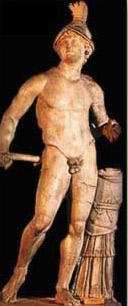Alexander the Great Spurs Fresh Gold Rush
by Egyptian Government

Veteran explorers and amateur enthusiasts share strong infatuation with the Pyramids, obelisks and royal tombs. However, an increasing number of explorers are obsessed with the myth of the yet unfound tomb of Alexander the Great.
Alexander the Great died in Babylon in the summer of 323 BC. In his brief reign he not only conquered the greatest part of the then known world, but brought vast changes to the regions of the empire that he built.
His life and deeds, as well as his death and burial, became a legend for future generations, far beyond the lands he had conquered.
In fact, until the Renaissance, it is the legend of Alexander that prevailed, as reliable historical sources were practically unknown.
The legend differed greatly from one region to another and was adapted and merged with pre-existing local traditions. The legend of Alexander started spreading right after Alexander's death and overshadowed his real life.
Alexander became a mythical figure, a theme for folk-songs, epics and anecdotes. Even his name was modified or distorted.

Obsession with Alexander the Great spurred a bout of fervent search reminiscent of the Gold Rush days in the US. Unfortunately, this obsession has hatched a breed of greedy maniacs who decided to carry out search activities on their own without counting on any scientific evidence or enlisting the help of expert explorers.
Certainly nobody bothered to obtain permits from the Supreme Council for Antiquities (SCA), considering that most search efforts were carried out covertly, not to mention that SCA doesn't have the tools to monitor violations.
Surprisingly, however, the SCA Secretary General belittled the importance of these search activities affirming that nobody has conclusive clues about the exact location of the tomb.
He added that most people work on basis on inconclusive evidence and insisted that the discovery of the tomb would most likely take place by mere coincidence.

"It will most likely be discovered by mere coincidence, not organized search activities," he said.
The strangest unauthorized search case is currently being investigated by al-Dekheila Prosecution, which ordered the arrest of a factory worker who initiated a massive search for the tomb in a desert area.
The worker, who obviously has absolutely nothing to do with antiquities, said he knew the exact location only two days ago. "I was asleep and I saw a vision. Somebody told me I must dig for the tomb in this area," he said.
This was not the first incident, nor would it be the last, especially with Alexander the Great conjuring up images of fabulous riches. More people seem interested in the possible religious significance of the tomb as they tend to link Alexander the Great with the Alexander mentioned in the Holy Koran.

Approximately a year ago, the police arrested a Greek waiter who believed the tomb lie under the Roman amphitheatre in Alexandria. He carried out search activities single-handedly even though he couldn't provide a shred of evidence to corroborate his belief.
Even more exciting is the story of an Egyptian fuul and falafel seller who gave up his work and dedicated himself to searching for Alexander the Great's tomb. He dug a long tunnel along the main road of Al-Agamy area without explaining the reason of digging to anybody.
However, as he approached the residential area of Al-Agamy, some locals made a report to the police which apprehended the man and ordered the tunnel to be refilled.
During the investigation he revealed that he stumbled across an ancient book in which he read about the location of the tomb. Even though he doesn't have a clue about, or interest in, history, he just pressed ahead with this operation in the hope of finding the treasures of Alexander and move from rags to riches.

Commenting on these obsessions, professor of history Mohammed el-Kahlawi of Cairo University, said it was a bizarre situation of facts overlapping with illusions.
He added that anybody who seeks fame or some financial assistance from Greece can simply launch an expedition to search for Alexander the Great's tomb although there hasn't been any reliable clue as to the whereabouts of this mysterious tomb.
He added that all the expert search activities carried out so far were unsuccessful.
This view corresponds to the argument of noted historian Harry E. Tzalas who noted that a dense veil of mystery has covered the burial of Alexander the Great, and it has become difficult to distinguish the historical facts from the legend.
The legend was first woven in Greco-Roman times, and continued with additions in the Christian then Arab periods.
According to Tzalas, nearly everything related to Alexander's burial has become the subject of controversy. He argued, however, that the story of Diodorus Siculus should be accepted as reliable.
According to this story the body was embalmed and that after numerous vicissitudes and a delay of two years, the funeral convoy started on the long journey to Egypt.

"Was the intended destination the Oasis of Siwa, where the oracle of Amun had confirmed, some years earlier, his divine Lineage? Or was this a trick of Ptolemy Lagos (337-283), who wanted the body of the conqueror to be buried in Alexandria, in order to fulfill the prophecy of Aristander, Alexander's favorite soothsayer, who had predicted "that the country in which his body was buried would be the most prosperous in the world"? It is difficult to judge," he said.
Meanwhile, Saleh Lamie, professor of antiquity restoration at the university of Beirut, dismissed it as imprecise rumors suggesting that the tomb is located near the mosque of Nabi Danial (Prophet Danial).
Nabi Danial mosque was the location alleged to be Alexander's tomb. The two mosques Nabi Danial and Athanasius are not far away from each other, and some confusion during the dark ages of Alexandria can be justified.
The present Mosque of Nabi Danial was built at the end of the 18th century and restored in 1823 by Mohammed Ali. A smaller shrine, probably the mosque of Dzoul Karnein - the Sire with the two horns - pre-existed on the site.
Professor Lamie said an expedition in 1943 carried out intensive search in the area to verify the accuracy of this piece of information but to no avail.
He also explained that several archeological studies about the site of Al-Nabi Danial have not made any reference to the tomb of Alexander the Great.
The former Secretary General of SCA, Abdel Halim Nour Eddin, was not surprised that Alexander the Great should muster this tremendous admiration.
"We are talking about a rare icon in history and hundreds of people tried to find the mysterious tomb but to no avail," he said. Most of the search activities were centered near Gabanet el-Latin (Latin Graveyard), al-Nabi Danial Mosque and the Roman amphitheatre, but none of these produced any positive results.
"We need to have more research about this issue and I think it will be useful for people who have information about the tomb to present them to the SCA to piece together a comprehensive theory on the tentative whereabouts of the tomb," he said.

